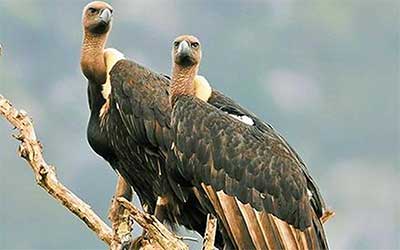Daily-current-affairs /
05 Nov 2020
Vulture Conservation : Daily Current Affairs

Vulture Conservation
Why in NEWS ?
- The National Board for Wildlife (NBWL) has cleared a plan for conserving vultures.
About
- The drugs that are used to treat cattle and known to poison vultures will be banned
by the Drugs Controller General of India.
- Diclofenac, a drug used to treat cattle, was linked to kidney failure in vultures and a
decline in the bird’s population.
- Though the drug was banned in 2006, it is reportedly still available for use.
Need for Ban
- A study by the Bombay Natural History Society (BNHS) and the Royal Society for the
Protection of Birds’ Centre for Conservation Science found that along with
Diclofenac, there were several other drugs that were potentially toxic to vultures
being used by vets for treating cattle.
- The drugs make their way into the vulture’s system as they feed on carcasses.
- Three of India’s vulture species of the genus ‘Gyps’ — the long-billed (Gyps indicus)
and the slender-billed (Gyps tenuirostris) had declined by 97%, while in the white-
rumped (Gyps bengalensis) declined nearly 99% between 1992 and 2007, according
to an earlier estimate by the BNHS.
- These three vulture species were listed by IUCN, in 2000
as ‘Critically endangered’, which is the highest category of endangerment.
- This would be done through both ex-situ and in-situ conservation.
- The plan has also suggested that new veterinary non-steroidal anti-inflammatory
drugs (NSAIDS) be tested on vultures before their commercial release. NSAIDS often
poisons cattle whose carcasses the birds pray on.
Significance of Vultures
- Vultures are often overlooked and perceived as lowly scavengers, but they play a
crucial role in the environments in which they live.
- The scavenging lifestyle that gives them a bad reputation is, in fact, that makes them
so important for the environment, nature and society.
- Vultures, also known as nature’s cleanup crew, do the dirty work of cleaning up after
death, helping to keep ecosystems healthy as they act as natural carcass recyclers.
Action Plan for Vulture Conservation 2020-2025
- The plan was approved by the National Board for Wildlife (NBWL) in its meeting on
October 5.
- A coordinated Nation-wide vulture counting is to be conducted by the Bombay
Natural History Society, Forest Department, non-profit organisations, Research
Institute, etc. These counting are to be conducted at regular intervals.
- The plan has suggested that new veterinary non-steroidal anti-inflammatory drugs
be tested on vultures before they are commercially released.
- The new plan automatically removes veterinary use of a drug if it is found to be toxic
to vultures. This is to be done with the help of Drugs Controller General of India.
- Under the plan, every state will host at least one vulture safe zone to conserve the
remnant population of vultures in the state. These centres will facilitate conservation
and breeding of vultures.
- Conservation breeding of red-Headed vultures and Egyptian vultures and the
establishment at least one vulture-safe zone in each state for the conservation of the
remnant populations in that state.
- A database on emerging threats to vulture conservation, including collision and
electrocution, unintentional poisoning, etc.
- The ‘Action Plan for Vulture Conservation 2020-2025’ also proposes to establish
Vulture Conservation Breeding Centres in Uttar Pradesh, Tripura, Maharashtra,
Karnataka and Tamil Nadu. There would also be a conservation breeding programme
for the Red Headed vulture and Egyptian vulture, and at least one “Vulture Safe
Zone” in every State for the conservation of the remnant populations.
- There would be four rescue centres in different geographical areas: Pinjore in north
India, Bhopal in central India, Guwahati in northeast India and Hyderabad in south
India, as well as regular surveys to track population numbers, the plan envisages.
National Board for Wildlife
- The NBWL is constituted by the Central Government under Section 5 A of the
Wildlife (Protection) Act, 1972 (WLPA).
- It serves as an apex body to review all wildlife-related matters and approve projects
in and around national parks and sanctuaries.
- The board is advisory in nature and advises the Central Government on framing
policies and measures for conservation of wildlife in the country.
Composition
- It is chaired by India’s Prime Minister and its vice-chairman is Minister of
Environment.
- The NBWL has 47 members including the chairperson.
- Among these, 19 members are ex-officio members.
- Every new government constitutes a new board, based on the provisions of the
WLPA, with the new PM as the chair.
Functioning
- The primary function of the NBWL is to promote the conservation and development
of wildlife and forests.
- It has the power to review all wildlife-related matters and approve projects in and
around national parks and sanctuaries.
- No alternation of boundaries in national parks and wildlife sanctuaries can be done
without the approval of the NBWL.








